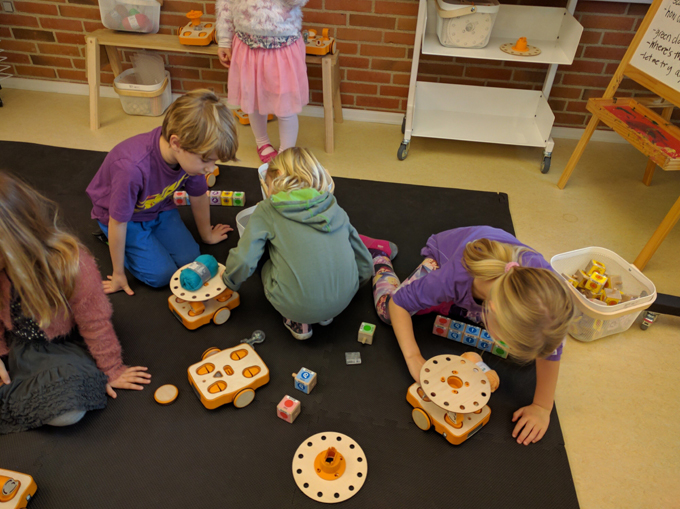
Sarah sits with a small class of 4- and 5-year-old students. She is teaching students to use a KIBO robotics kit, which uses a tangible programming language for children made of wooden blocks. At the heart of her lesson is a maze task. There is a start spot and end spot demarcated on the carpet. First, to get comfortable with the idea of commands, the students play a game called “Program the Teacher.” Sarah invites students to get her through the maze using the KIBO language. KIBO can step forward and backward, turn, shake, spin, beep, and sing (KIBO plays a short melody). The students jump right in:
“Sing!”
“Beep!”
“Shake!”
“Spin!”
Reluctantly, Sarah obliges, but probes the students: “Is this going to get me where we want me to go?”
“No,” they reply, “but it’s fun.” The students are clearly excited by the KIBO programming language, they just don’t care that much about the maze.
“OK. Straight,” they oblige.
Sarah immediately shows excitement. “How many steps?” she asks.
“Three,” they answer. “OK, now sing again!”
The activity continues until, through a series of probes and pushes, Sarah gets the students to tell her to walk straight and then turn so that she can get through the maze.
 Next, they try to get an actual KIBO through the maze. It doesn’t go much better. They want KIBO to sing and beep and shake and spin. Sarah gently asks them whether their program will get KIBO from the start spot to the end spot. But they’re too busy experimenting with KIBO, the performer, to worry about the task Sarah has assigned them. At one point, they make KIBO lurch around the room spinning and they run in circles squealing, “It’s eating my feet! It’s eating my feet!” Sarah tries one more time: “But, tell me, how can I get KIBO to the end spot?” With utter sincerity, one student answers, “You could pick him up and move him.” Sarah calls a snack break.
Next, they try to get an actual KIBO through the maze. It doesn’t go much better. They want KIBO to sing and beep and shake and spin. Sarah gently asks them whether their program will get KIBO from the start spot to the end spot. But they’re too busy experimenting with KIBO, the performer, to worry about the task Sarah has assigned them. At one point, they make KIBO lurch around the room spinning and they run in circles squealing, “It’s eating my feet! It’s eating my feet!” Sarah tries one more time: “But, tell me, how can I get KIBO to the end spot?” With utter sincerity, one student answers, “You could pick him up and move him.” Sarah calls a snack break.
There was no problem with KIBO. In fact, the students loved playing with KIBO. They quickly mastered the idea of using commands to make KIBO follow their instructions. They just didn’t care about the maze task.
Literacy educators have long known that students are far more likely to take on a cognitive challenge when they care about the task assigned. The anecdote above sheds light on what kinds of activities teachers should design to teach young children programming languages.
Learning programming languages is like learning to read and write a new language. Experts in literacy stress that students can only learn to read and write when teachers give them activities that leave room for their own self-expression. In a 2007 Research in the Teaching of English article, literacy scholar Maren Aukerman explains, “When reading instruction principally focuses on a teacher’s interpretation and interpretive techniques, we misrepresent to children what reading actually is.” When literacy instruction focuses solely on phonics, or the transmission of authoritative interpretations, reading in schools becomes cut off from the reading children do outside of school. Outside of school, children (and adults) read and interpret as part of the natural activity of sense-making. Inside of school, it’s easy to lose this most basic purpose for reading and writing. At the heart of the balanced literacy approach is the understanding that students learn literacy better when it’s taught through tasks that matter to them (i.e., tasks that make room for their self-expression and sense-making).
The students in this anecdote were not interested in the maze task their teacher assigned. As such, they could not get into the cognitive work it required. The task wasn’t guided by their own questions or curiosities. I can’t help but wonder how the outcomes would have differed had they been allowed to explore KIBO’s performance capabilities. Imagine if they had gone through the process of developing a performance for KIBO, writing the program for that performance, and reflecting on how their written program did and did not realize their vision. Instead, their interests were continually thwarted in service of the task at hand—a task that didn’t hold the students’ engagement.
In the November/December 2018 issue of Literacy Today, educator Chris Panell wrote, “Those who are digitally literate in the future will be those who can read not only the surface of the text, but also the programming that makes it appear as it does.” Panell is correct in connecting the two. We would go one step further and connect how we teach students to read both “the surface of the text” and “the programming that makes it appear.” Educators must think about the teaching of programming languages like we think about the teaching of literacy and natural language, emphasizing student meaning-making, imagination, and creativity.
It’s much easier to ask students to write a program that moves a robot from a start spot to an end spot than it is to allow them open exploration of this block programming language. However, the nascent field of early childhood programming education need not repeat the mistakes of the past. It must take as its starting place the hard-learned lessons from literacy education: Students learn more when the task matters to them.
Ziva R. Hassenfeld, an ILA member since 2016, earned her doctorate in curriculum and teacher education from Stanford University in 2016. She is currently a middle school teacher in the Boston area and a post-doctoral fellow at the Dev Tech Research Group of Tufts University and at Brandeis University. Her research focuses on the tools and reading strategies young children employ when reading texts, as well as the pedagogies teachers use to support student textual interpretation, fluency, and comprehension.
Marina Umaschi Bers is professor and chair at the Eliot-Pearson Department of Child Study and Human Development and an adjunct professor in the Computer Science Department at Tufts University. She heads the interdisciplinary Developmental Technologies research group. Her research involves the design and study of innovative learning technologies to promote children’s positive development. She also developed and serves as director of the graduate certificate program on Early Childhood Technology at Tufts University.